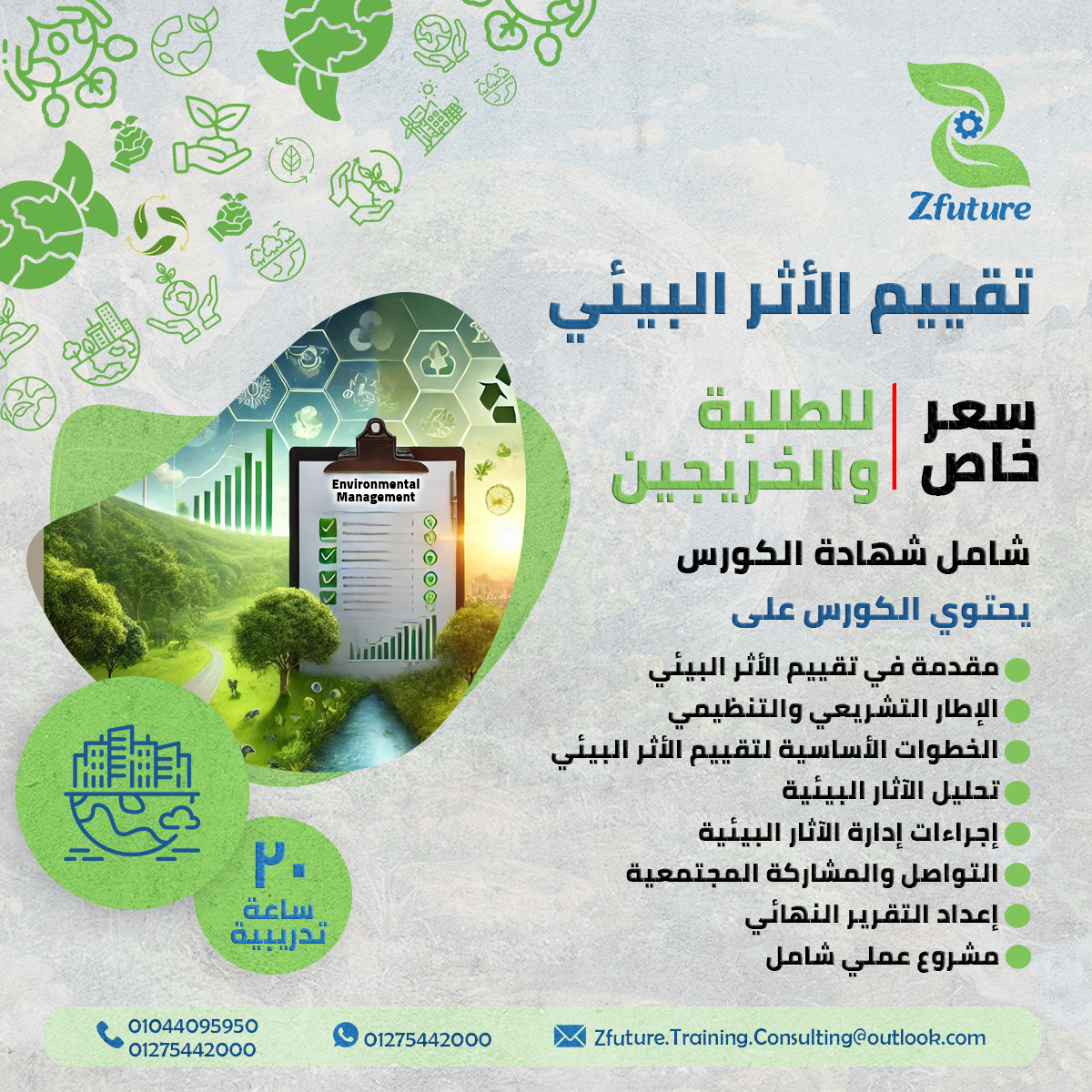Environmental Impact Assessment (EIA) Course:
Environmental Impact Assessment course (EIA) is a fundamental tool for environmental protection and informed decision-making in sustainable development. This course aims to assess the potential impacts—whether positive or negative—that may result from any project or human activity before its implementation. Through this comprehensive process, potential environmental risks are identified, and plans are developed to mitigate or avoid them, contributing to achieving sustainable development. Contact us for full details, free of charge.
The Environmental Impact Assessment course begins with the planning and preparation phase, where the project scope is determined, and stakeholders and beneficiaries are identified. Then, necessary data and information about the natural, social, and economic environment of the affected area are collected. Afterward, a comprehensive analysis of the expected environmental impacts is conducted, including the effects of the project on air, water, soil, ecosystems, biodiversity, public health, and aesthetics.
Contact us now for free to get all the details about the training courses available from Zfuture Consulting and Training Company.
Content of the Environmental Impact Assessment course (EIA) :
Definition of Environmental Impact Assessment course (EIA) and its importance in the enjoyment of natural resources.
The relationship between EIA and chemical consumption.
The legal and regulatory framework.
Local laws related to environmental assessment.
The importance of adhering to the legal and regulatory framework in achieving environmental impact.
Basic steps for environmental impact assessment:
Scoping and environmental components affected by the project.
Methods for collecting and analyzing harmful impacts.
Analysis of harmful impacts.
Methodologies for assessing positive and negative impacts of organizations.
Studying alternative options and environmental impacts.
Procedures for managing harmful impacts.
How to establish general management of harmful impacts.
To align with the project’s plans.
Community participation.
Communication with the local community and small families.
Community methods in the simple EIA stages.
Final quarter preparation.
Criteria for preparing an EIA report.
How to submit applications to judicial courts and obtain approval.
Comprehensive practical project.
Comprehensive application of an EIA for a hypothetical project.
Preparation of a final report that includes all assessment steps according to the Egyptian Ministry of Environment’s instructions.
Benefits of the Environmental Impact Assessment course (EIA) :
- Flexible Training: The course can be offered online.
- Certified Certificate: Participants will receive a certificate upon completing the EIA course.
- Updated Training Materials: Based on best international practices.
- Practical Project: Helps participants apply what they’ve learned directly in a real-world scenario.
Duration of the Environmental Impact Assessment course (EIA) :
The duration of the EIA course is 20 training hours, with expert instructors from ZFuture Consulting and Training.
Price of the Environmental Impact Assessment course (EIA) :
There is a special discounted price for students and graduates in the EIA course. Contact us via WhatsApp for full details, free of charge.
Objective of the Environmental Impact Assessment course (EIA) :
- Enhance the skills of employees in both the public and private sectors in environmental impact assessment.
- Achieve integration and harmony among concerned parties in EIA procedures and techniques.
- Learn the latest methods and techniques for analyzing and assessing environmental impacts.
- Exchange knowledge and experiences among participants to improve their performance.
- Conduct comprehensive and effective environmental impact assessments.
- Understand the environmental impacts of projects and make informed decisions.
- Apply the best global practices in environmental impact assessment.
- Contribute to sustainable development: Protecting the environment while balancing economic and social development.
- Obtain a certified certificate that helps you secure genuine job opportunities after completing the EIA course.

Necessary Tools for Enrolling in the Environmental Impact Assessment Course (EIA) :
- A device connected to the internet
- Zoom application
Environmental Courses
ZFuture Consulting and Training offers various environmental courses in addition to the Environmental Impact Assessment course, such as:
- Sustainable Development Course
- Carbon Footprint Course
- Occupational Safety and Health Course
You can explore all the courses we offer through the Training Courses page.
What is Environmental Impact Assessment Course (EIA)?
Environmental Impact Assessment course (EIA) is a systematic process used to identify and evaluate the potential environmental impacts of a project. Environmental consulting companies should be involved in projects, whether industrial, engineering, agricultural, or other types. The main goal of this assessment is to ensure that the project does not cause significant environmental harm and is implemented in a sustainable manner.
EIA is defined as an activity designed to identify the potential impacts of a specific project using procedures and measures to prevent or reduce negative effects or enhance positive outcomes, in line with applicable environmental standards. It helps companies and projects meet the requirements for operational licenses.
Objectives of Environmental Impact Assessment for Projects:
- Identify, predict, and assess the economic, environmental, and social impacts of development activities.
- Provide information on the environmental consequences to support decision-making.
- Promote environmentally sound and sustainable development by identifying appropriate alternatives and mitigation measures.
- EIA is widely accepted as a tool for ensuring sustainable development with minimal environmental degradation.
Importance of Environmental Impact Assessment:
- Environmental Preservation: Helps identify potential negative impacts on air, water, soil, ecosystems, and wildlife.
- Informed Decision-Making: Provides the necessary information for making decisions about the project, including modifying the design or choosing an alternative location.
- Compliance with Regulations: Ensures compliance with environmental laws and regulations.
- Transparency: Raises public awareness of the environmental impacts of the project and provides an opportunity for participation in decision-making.
- Sustainability: Contributes to sustainable development by ensuring that projects do not harm the environment or society.

Stages of Environmental Impact Assessment course (EIA):
- Screening and Scoping: In this phase, projects that require a detailed Environmental Impact Assessment course (EIA) study are identified based on the project’s size, type, and expected environmental impacts. Projects are classified into those that need a comprehensive assessment and those requiring a partial assessment.
- Defining the Scope: After identifying the targeted projects, the environmental aspects to be focused on in the study are determined. This includes identifying sensitive environmental elements such as air, water, soil, ecosystems, and biodiversity that may be impacted by the project. The geographic and temporal scope of the study is also defined.
- Analysis and Evaluation: This is one of the most critical stages of the EIA process, where the potential environmental impacts of the project are analyzed, both positive and negative, for the short-term and long-term. Analytical tools and models are used to assess the intensity and extent of these impacts. Different alternatives are developed to avoid or reduce negative impacts and enhance positive effects.
- Reporting and Review: After the analysis and evaluation phase, a comprehensive report is prepared, detailing the study’s findings, including the expected impacts, proposed alternatives, and recommendations. This report is presented to relevant authorities and the public for feedback.
- Decision-Making and Monitoring: Based on the assessment results and the feedback received, a final decision is made regarding whether to approve the project and the conditions for approval. If the project is approved, an environmental management plan is created to ensure that the preventive and mitigation measures are implemented. This is what you will learn in the EIA course.
Benefits of Environmental Impact Assessment:
Environmental Impact Assessment is a systematic process used to identify and evaluate the potential environmental impacts of a project before its implementation. The goal of this assessment is to ensure that the project does not cause significant harm to the environment and is implemented in a sustainable manner.
Why is Environmental Impact Assessment Important?
- Environmental Preservation: Helps identify potential negative effects on air, water, soil, ecosystems, and wildlife.
- Informed Decision-Making: Provides necessary information to make decisions about the project, including the possibility of modifying the design or choosing an alternative location.
- Compliance with Regulations: Ensures compliance with environmental laws and regulations.
- Transparency: Informs the public about the project’s environmental impacts and provides opportunities for public participation in decision-making.
- Sustainability: Contributes to sustainable development by ensuring that projects do not harm the environment or society.
Key Projects for EIA Application:
Environmental Impact Assessment of Wastewater Treatment Plants
The environmental impacts of wastewater treatment plants are assessed by studying and analyzing a set of vital factors, including:
Leakage Characteristics: Evaluating the potential for water leakage into the central treatment plant or contaminated materials from the network pipes, with a focus on water quality and drinking water networks.
Geographic Location: Studying the location of primary water sources and population centers, and their impact on the environment through selected options.
Network Design: Evaluating the network design in terms of the necessity of transferring water from the central treatment plant, the type of construction materials used, and the speed of response, thus ensuring the prevention of leaks.
Groundwater Impact: Studying the depth of the network relative to the groundwater table and the impact of treatment processes on groundwater quality.
Treated Water Discharge: Determining the location of the treated water discharge, whether to a secondary plant or a natural physical waste, and the impact on the aquatic environment.
Equipment: Connecticut’s innovation and repair system, thanks to its continuity, is a marvel that enables innovation.
Impact on Society: The social impact of the station, including its impact on suspension quality and potential negative impacts on air quality, noise, and recovery from the station.
Environmental Impact Assessment of Tourism Impacts
Each tourism project must be selected and evaluated comprehensively throughout the project, from the planning stage through operation and maintenance. This assessment aims to identify the damage caused by adverse environmental effects, such as carbon emissions, water pollution, solid and liquid waste, noise, and impacts on wildlife and marine life.
Environmental Impact Assessment of Hospitals
The environmental impact of waste is assessed to determine its compliance with the country’s laws and regulations. This is accomplished through:
Developing the hospital’s feed line.
Preparing a register of hazardous materials and waste.
Evaluating hospital sanitation.
Waste and hazardous waste management.
Environmental conflicts in the workplace.
Corruption.
Environmental Impact Assessment of Projects
Environmental impact assessment of projects is a comprehensive strategy for studying the factors affecting the environment prior to implementation. It gathers basic information about environmental elements and their impact on various environmental components, such as fresh air, soil, and biodiversity. It also examines social impacts, and then develops a project management plan. This plan includes measures to address impacts, monitoring, and evaluation, with the goal of effective and efficient development. This reduces the need for project design calculations and no certified efficiency.

Definition and Objectives:
An Environmental Impact Assessment (EIA) is a detailed study aimed at identifying and evaluating the potential environmental impacts of a project before its implementation. It helps in making appropriate decisions to protect the environment and natural resources while ensuring sustainable development and a balance between economic growth and environmental protection.
Stages of Environmental Evaluation:
- Preliminary Stage:
- Defining the scope and characteristics of the project.
- Collecting baseline data on the surrounding environment.
- Identifying legal and regulatory requirements.
- Impact Analysis:
- Studying impacts on air, water, and soil.
- Evaluating the effects on biodiversity and ecosystems.
Environmental Impact Assessment of a Factory:
The environmental impact assessment of a factory is a systematic process aimed at evaluating the potential impacts that the establishment and operation of a factory might have on the surrounding environment. This study is essential to ensure that the factory operates in a sustainable way and does not cause significant harm to the environment.
Why do Factories Need an Environmental Impact Assessment?
- Environmental Preservation:
The study aims to identify and evaluate potential negative impacts of the factory on air, water, soil, ecosystems, and wildlife, and suggest solutions to mitigate these impacts. - Compliance with Laws:
Many countries enforce strict laws and regulations that require conducting an environmental impact assessment before approving the establishment of any industrial project. - Improving Reputation:
An environmental impact assessment demonstrates the company’s commitment to environmental preservation, enhancing its reputation and image. - Informed Decision-Making:
The study helps in making well-informed decisions about the factory’s location, design, and operations, ensuring a balance between economic growth and environmental preservation.
Environmental Impact Assessment and Obtaining Environmental Approval:
An environmental impact assessment course (EIA) is a systematic and scientific process aimed at evaluating the potential environmental impacts of a project or activity before its execution. The study identifies and evaluates both positive and negative potential impacts on air, water, soil, ecosystems, and wildlife to ensure that the project complies with environmental standards, laws, and regulations. After the study is completed, it is submitted to the relevant governmental authorities to obtain environmental approval, which is an official permit allowing the project to proceed, provided that necessary measures are taken to minimize negative environmental impacts and enhance positive impacts.
What is Environmental Approval?
Environmental approval is an official permit issued by the relevant governmental authority, such as the Ministry of Environment or the Environmental Affairs Agency, after ensuring that the project will not cause significant harm to the environment. It also ensures that the proposed measures in the assessment are adequate to reduce negative impacts.
How to Obtain Environmental Approval:
- Submit the Application:
An application for environmental approval is submitted to the relevant governmental authority, typically accompanied by a complete environmental impact assessment study. - Review and Evaluation:
The governmental authority carefully reviews and evaluates the study, considering the applicable environmental standards and regulations. - Public Hearing:
In some cases, public hearings may be held to allow the public and concerned organizations to express their views on the project. - Issuance of Decision:
After completing the review process, the governmental authority issues a decision on whether to approve or reject the project, outlining the conditions and obligations that the project executors must adhere to.

Frequently Asked Questions (FAQ):
How is Environmental Impact Assessment (EIA) conducted?
- Analysis of Environmental Elements: Analyze the environmental components of the project and its various activities.
- Establishing the Environmental Impact: Determining the potential environmental impact of the project.
- Proposing Solutions: Suggesting measures to mitigate the expected environmental impacts.
- Creating a Report for Decision-Makers: Preparing a report for the decision-makers outlining the findings and recommendations.
- Steps Involved:
- Identification and Description: Identify and describe the project and its potential impacts.
- Analysis: Analyze the environmental consequences of the project.
- Evaluation: Evaluate the severity of the potential impacts.
- Options: Provide possible alternatives to reduce negative impacts.
- Final Evaluation: Make a final assessment of the project’s environmental impact.
- Follow-up and Monitoring: Ensure continuous monitoring to assess the ongoing impact.
What is Strategic Environmental Impact Assessment (SEA) and its goal?
Strategic Environmental Impact Assessment (SEA) is a planning tool used to assess the potential environmental impacts of policies, plans, and programs before they are implemented. It’s a forward-looking process that aims to understand how major strategic decisions will affect the environment.
What is the goal of Strategic Environmental Impact Assessment (SEA)?
- Integrating Environmental Considerations: SEA seeks to integrate environmental considerations into decision-making from the outset, rather than as an afterthought.
- Avoiding Negative Impacts: SEA aims to identify potential negative environmental impacts of proposed policies and plans, and put measures in place to mitigate or avoid them.
- Promoting Sustainability: SEA focuses on selecting the most sustainable options that balance economic, social, and environmental needs.
- Increasing Transparency and Participation: SEA encourages public participation in the decision-making process, increasing transparency and accountability.
What is the concept of environmental impact?
The concept of environmental impact refers to any change in the environment resulting from human activity. This change can be positive or negative and can affect the air, water, soil, plants, animals, and even humans.
What are environmental reports?
Environmental reports are comprehensive documents that provide a detailed analysis of the environmental condition of a specific area or project.
Why is an environmental impact study important when planning major economic projects?
Environmental impact studies are essential when planning any major economic project, whether it’s a new factory, a dam, or infrastructure development. This study identifies the potential positive or negative effects of the project on the surrounding environment and helps in making informed decisions to mitigate negative impacts and enhance positive effects.
What does EIA mean?
Environmental Impact Assessment course(EIA) is a systematic and scientific process used to identify and assess the potential environmental impacts of any project or activity before its execution.
What are the best Environmental Impact Assessment (EIA) companies in Egypt?
Zfuture Consulting and Training Company is considered one of the best companies for Environmental Impact Assessment (EIA) in Egypt.


Hi SIR/ Madam.
Please sent me a quote of Environmental Impact Assessment Course and content
please contact us +201080833841